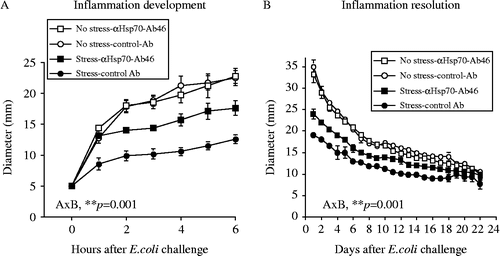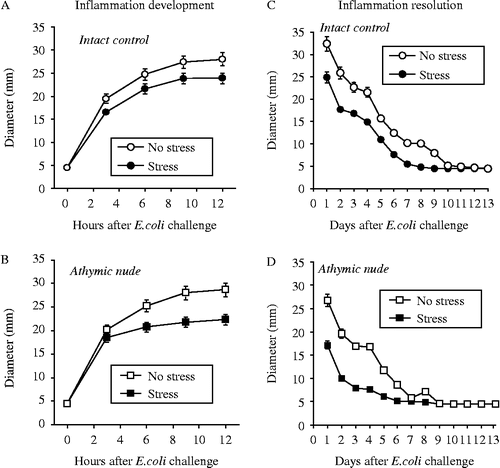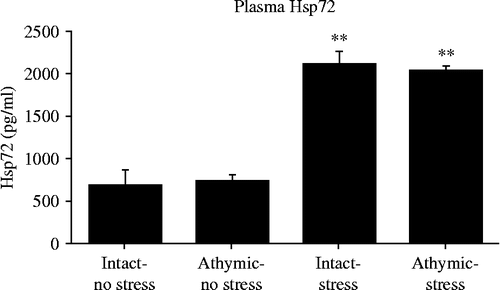Figures & data
Figure 1. Adult, male F344 rats were either exposed to 100, 5-s, 1.6 mÅ, inescapable tail-shocks (stress) or remained in their home cages as no stress controls. Immediately following stressor termination, all rats were injected subcutaneously with ∼2.5 × 08 CFU of E. coli and either anti-Hsp70-Ab46 or mouse IgG1 control antibody. Inflammation diameter was measured hourly (A) to assess development (0–12 h) and daily (B) to assess resolution (1–25 days) after E. coli challenge. RMANOVA revealed a main effect of tail-shock and anti-Hsp70-Ab46 on both inflammation development (A) and resolution (B; p's < 0.0001). There was a main effect of antibody on inflammation development (A; p ≤ 0.001) and resolution (B; p ≤ 0.05). A stress × antibody interaction (A × B) was found for development (A; p < 0.001) and resolution (B; p < 0.001) of inflammation. Data are group mean ± SE of the mean; 4–8 rats/group. CFU, colony-forming units; Hsp, heat shock protein; Ig, immunoglobulin.

Figure 2. Adult, male rnu+ (A, C) and rnu/rnu (B, D) athymic nude rats were either exposed to 100, 5 s, 1.6 mÅ, inescapable tail-shocks (stress) or remained in their home cages as no stress controls. Immediately following stressor termination, all rats were injected subcutaneously with ∼2.5 × 108 (CFU) of E. coli. Inflammation diameter was measured hourly to assess development (0–12 h) and daily to assess resolution (1–25 days) after E. coli challenge. Rnu/+ (A) and athymic nude (rnu/rnu) (B) rats injected with E. coli immediately following tail-shock stress showed significantly reduced hourly development of inflammation over the course of the initial 12 h following injection (A,B). RMANOVA revealed a main effect of tail-shocks on the development of inflammation in Rnu/+ (A, p ≤ 0.001) and rnu/rnu rats (B, p ≤ 0.001). RMANOVA revealed that Rnu/+ rats that were injected with E. coli immediately following tail-shocks had a significant reduction in inflammation diameter measured 24 h following injection (i.e. on day 1; p = 0.0067; Figure 2C), and athymic nude (rnu/rnu) rats injected with E. coli immediately following stress also had a significant reduction (p = 0.0008; Figure 2D) in inflammation based on diameter measured on day 1. Exposure to stress in the athymic nude rats resulted in the greatest restriction and fastest recovery as compared to all other groups (group × strain × time interaction; p = 0.01). Data are group mean ± SE of the mean; 4–8 rats/group. CFU, colony-forming units.

Figure 3. Adult, male rnu+ and rnu/rnu athymic nude rats were either exposed to 100, 5 s, 1.6 mÅ, inescapable tail-shocks (stress) or remained in their home cages as no stress controls. Immediately following stressor termination, all rats were rapidly decapitated and plasma collected. Hsp72 concentrations were measured using ELISA. ANOVA indicated that both athymic nude rats and heterozygous intact control rats exposed to tail-shocks (stress) increased plasma eHsp72 concentration compared to no stress controls (p = 0.0001). Data are group mean ± SE of the mean; 4–8 rats/group. ELISA, enzyme-linked immunosorbent assay; eHsp, extracellular heat shock protein.
